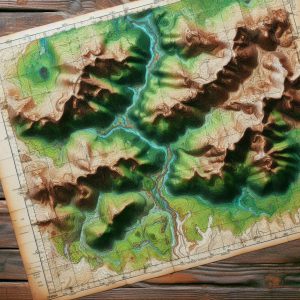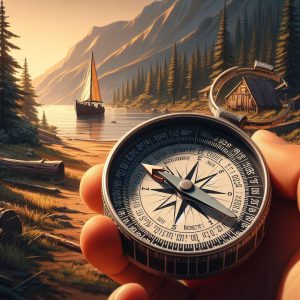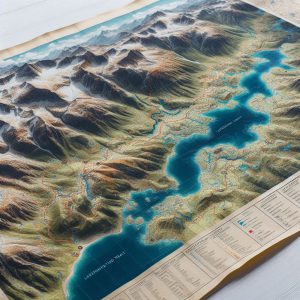
Wilderness Navigation Techniques for Off-Grid Adventures
Sharpen Your Wilderness Navigation Skills: A Detailed Guide for Adventurers Navigating Without GPS
Becoming proficient in wilderness navigation without relying on modern technology may seem daunting at first. However, mastering essential map and compass navigation techniques is an invaluable skill set that can greatly enhance your outdoor escapades. Effective navigation hinges on a thorough understanding of your environment and the ability to assess your current location in relation to your desired endpoint. A well-crafted map provides a comprehensive two-dimensional representation of the land, while a compass serves as a dependable tool for orienting yourself according to the four cardinal directions: north, south, east, and west. By refining your skills with these navigational instruments, you can confidently embark on outdoor adventures without the constraints of technological devices.
To begin your journey into navigation, immerse yourself in learning the various symbols and scales featured on a map; understanding these components is vital for interpreting the real-world landscape accurately. A solid foundation in reading contour lines, which indicate elevation changes, is crucial. This knowledge enables you to recognize hills, valleys, and other geographical formations that may influence your chosen path. Additionally, gaining proficiency in using a compass is equally important, as it empowers you to navigate through the wilderness independently, without the reliance on GPS technology.
The compass needle consistently points toward magnetic north, which allows you to align your map with the real terrain. To accomplish this, hold your compass level in your hand and rotate the map until the magnetic north indicated on the compass aligns with the north displayed on your map. This essential step, referred to as “orienting the map,” is critical for maintaining accuracy in your navigation efforts and ensuring that you remain on the correct path toward your destination.
Once your map is accurately oriented, you can utilize the compass to take precise bearings that will guide your course of travel. By effectively integrating these two powerful navigational tools—the map and the compass—you will be able to confidently navigate through unfamiliar landscapes and ensure that you stay on track, even in the absence of modern technological assistance.
Key Principles for Mastering Outdoor Navigation Techniques
- Gaining proficiency in map and compass navigation is essential for anyone engaging in wilderness exploration or outdoor recreational activities.
- Topographic maps offer intricate details about the terrain, elevation changes, and natural features that are crucial for effective navigation.
- A compass not only determines direction but also aids in effective navigation by aligning with the map’s orientation and understanding magnetic north.
- Natural landmarks and indicators, such as distinctive rock formations or unique tree arrangements, can serve as valuable navigational aids when a map or compass isn’t readily available.
- Estimating distance and travel time is fundamental for planning and executing a successful navigation strategy in the wilderness.
 The Crucial Importance of Topographic Maps in Wilderness Navigation
The Crucial Importance of Topographic Maps in Wilderness Navigation
Topographic maps are essential tools for anyone planning a journey into the wilderness. These maps provide extensive insights into the physical characteristics of the terrain, utilizing contour lines to depict changes in elevation. This representation allows you to visualize the landscape’s contours and steepness, preparing you for the challenges that lie ahead. Each contour line connects areas of equal elevation, and the spacing between these lines indicates whether the slope is steep or gradual, equipping you with necessary knowledge for effective navigation.
Understanding Contour Lines and Map Symbols for Enhanced Navigation
When exploring a topographic map, it’s essential to closely analyze the patterns created by contour lines; closely spaced lines signify steep terrain, while widely spaced lines indicate flatter regions. This understanding empowers you to anticipate potential obstacles along your chosen route, enabling more informed navigation decisions. Additionally, topographic maps are filled with symbols representing various landmarks, including rivers, roads, trails, and diverse types of vegetation. Familiarizing yourself with these symbols is foundational for effective navigation, ensuring you can utilize the map to its fullest potential.
Developing Navigation Techniques with Topographic Maps
For instance, blue lines typically denote the presence of water bodies, such as streams or lakes, while green areas often represent forests or dense vegetation. By correlating these symbols with your surroundings, you can verify your location and make necessary adjustments to your route. Moreover, topographic maps often include grid lines that assist you in pinpointing coordinates, allowing for even greater precision in navigation. By mastering the intricacies of topographic maps, you will not only deepen your appreciation for the landscape but also enhance your overall navigational skills in the wild.
 Leveraging the Compass for Accurate Directional Navigation
Leveraging the Compass for Accurate Directional Navigation
A compass is an indispensable tool for any adventurer, offering invaluable assistance in directional navigation, particularly when traversing unfamiliar landscapes. To effectively utilize a compass, start by holding it level in front of you and allowing the needle to stabilize. The needle will point toward magnetic north, which may vary slightly from true north due to magnetic declination—the angle between magnetic and true north that shifts based on your geographical location.
Before embarking on your adventure, it is crucial to determine the local declination and adjust your compass accordingly. This adjustment is vital for maintaining accurate bearings, ensuring you stay on course throughout your journey. Once your compass is calibrated for declination, you can proceed to take a bearing that will guide your direction of travel.
To take a bearing, identify a landmark you wish to navigate toward and rotate the compass housing until the orienting arrow aligns with the magnetic needle. The degree reading on the compass dial that aligns with the index line indicates your bearing. As you move toward your destination, periodically check your bearing to ensure you remain on the correct path.
If you find yourself veering off course, reorient your compass and adjust your path as necessary. By mastering these techniques, you will develop confidence in using a compass as a reliable navigational instrument during any outdoor adventure.
 Navigating Using Natural Landmarks and Signs for Efficient Wilderness Travel
Navigating Using Natural Landmarks and Signs for Efficient Wilderness Travel
While maps and compasses are fundamental navigational tools, keenly observing natural landmarks and cues can significantly enhance your ability to navigate the wilderness effectively. Distinctive features such as mountains, rivers, or unique tree formations can serve as invaluable reference points when traversing unfamiliar terrain. For example, if you know a particular mountain is situated to the east of your starting position, you can utilize it as a reliable guide to ensure you’re moving in the correct direction.
Moreover, familiarizing yourself with the unique characteristics of your surroundings will aid in constructing mental maps, allowing you to navigate without over-relying on tools. In addition to prominent landmarks, be attentive to natural signs that may indicate direction or changes in terrain. The sun’s position can serve as a helpful guiding factor; in the northern hemisphere, the sun rises in the east and sets in the west, providing a general sense of direction throughout the day.
Additionally, observing moss growth on trees—often more prevalent on the north side—can offer vital clues about orientation in dense forests. Animal trails can also provide directional hints; many animals follow established paths that may lead you toward water sources or other significant landmarks. By enhancing your ability to interpret these natural signs, you will refine your skills in navigating diverse environments.
Effectively Estimating Distance and Travel Time for Successful Wilderness Navigation
Accurately estimating distance and travel time is critical for successful navigation in wilderness areas. Understanding how far you have traveled and the expected time to reach your destination allows for better planning and helps avoid unforeseen challenges. One practical technique for estimating distance is pacing—counting your steps as you walk.
On average, an adult’s stride measures approximately 2.5 feet, meaning that by counting your steps over a known distance, you can gauge how far you’ve traveled based on your pace. Additionally, consider the type of terrain and elevation changes when estimating travel time. For example, traversing flat ground typically allows for quicker movement compared to navigating steep hills or rocky paths.
A common guideline suggests that one can cover roughly three miles per hour on flat terrain, but this estimate should be adjusted significantly when encountering challenging landscapes. By factoring in these variables and modifying your expectations accordingly, you will be better equipped for your journey and more capable of managing your time effectively.
Crafting an Effective Wilderness Route and Navigation Strategy
Designing Your Wilderness Route for Optimal Navigation Efficiency
Creating a practical navigation plan is essential before embarking on any wilderness adventure. Start by analyzing topographic maps of your intended exploration area, pinpointing potential routes based on prominent landmarks, existing trails, and available water sources. As you outline your route, consider factors such as elevation changes and terrain difficulty; ensuring your plan is realistic and achievable is of utmost importance.
Preparing for Unexpected Obstacles and Weather Variability
While planning your route, it’s wise to consider alternative paths in case you encounter unforeseen obstacles or abrupt changes in weather conditions. Having multiple options provides you with greater flexibility during your journey and contributes to your overall safety. This adaptability is essential for a successful and enjoyable wilderness experience, empowering you to navigate any challenges that may arise seamlessly.
Developing a Comprehensive Navigation Strategy
Once you’ve charted potential routes, create a detailed navigation plan that includes key waypoints. Mark these waypoints on your map and, if possible, note their coordinates, allowing you to track your progress as you navigate through the wilderness. Additionally, incorporate estimated travel times between waypoints and identify any potential hazards that may arise along your chosen route.
Ensuring a Safe and Rewarding Outdoor Experience
Thorough planning and anticipating challenges significantly enhance your chances of reaching your destination while enjoying a safe and fulfilling outdoor experience. A well-organized navigation strategy is vital for a successful wilderness adventure, ensuring that you can explore the great outdoors with confidence and assurance.
 Implementing Emergency Navigation Techniques for Unforeseen Situations
Implementing Emergency Navigation Techniques for Unforeseen Situations
Despite meticulous planning and preparation, unforeseen circumstances may arise during outdoor adventures that necessitate emergency navigation techniques. One crucial skill is the ability to backtrack; if you find yourself lost or disoriented, retracing your steps can often lead you back to familiar territory. To execute this effectively, pay close attention to distinctive landmarks or features along your route, which can serve as reference points when returning.
Another invaluable technique is celestial navigation, particularly useful when visibility allows—especially on clear nights or sunny days when stars or celestial bodies are visible. Familiarizing yourself with prominent constellations, such as the North Star (Polaris) in the northern hemisphere, can provide guidance, as it remains relatively fixed in position while other stars shift. By identifying Polaris and determining its angle above the horizon, you can ascertain true north without relying on a compass or map.
If you have a wristwatch or smartphone as a backup, utilizing it alongside celestial navigation can enhance your sense of direction during emergencies, helping you maintain your orientation even in challenging situations.
Elevate Your Wilderness Navigation Skills: Practical Strategies for Continuous Improvement
Enhancing your wilderness navigation skills requires commitment and consistent practice, but the rewards can greatly enrich your outdoor experiences. One effective strategy is to join local hiking groups or outdoor clubs, where members can share their knowledge and experiences related to navigation techniques. Engaging with seasoned navigators can provide valuable insights into best practices while offering hands-on learning opportunities across diverse terrains.
Another advantageous approach involves regularly practicing with maps and compasses in various environments—whether in urban settings or remote wilderness areas—to build your confidence in these essential skills. Set aside time for solo excursions where you intentionally navigate without technological aids; this practice will reinforce your abilities while allowing you to connect more deeply with nature. Additionally, consider maintaining a navigation journal to document routes taken, challenges encountered, and lessons learned during each adventure; this reflective practice will not only enhance your skills but also deepen your appreciation for navigating diverse landscapes.
By embracing these techniques and continuously refining your skills in map reading, compass usage, natural observation, distance estimation, route planning, emergency strategies, and sharing practical experiences with others, you will evolve into a more self-assured navigator, capable of thriving in any wilderness environment, even without the support of technology.
Common Questions About Wilderness Navigation Techniques
What does wilderness navigation encompass?
Wilderness navigation involves the skills and techniques necessary to determine and maintain a route through natural, often remote, and undeveloped areas. It encompasses the use of various tools and methods to stay on course and safely reach a desired destination.
What traditional methods are used in wilderness navigation?
Traditional wilderness navigation methods include the use of a map and compass, interpreting topographic features, observing natural landmarks, and applying celestial navigation techniques based on the sun, moon, and stars.
Why might someone prefer to navigate without GPS?
Many individuals choose to navigate without GPS for numerous reasons, including the desire to enhance their wilderness navigation skills, embrace the challenge of traditional methods, or prepare for potential GPS malfunctions or limited access to technology.
What benefits come from learning wilderness navigation without relying on GPS?
Acquiring wilderness navigation techniques independent of GPS can deepen one’s understanding of the natural environment, boost self-reliance and confidence, and provide a reliable backup plan in case of technology failures or restricted access to GPS devices.
What challenges may arise when navigating in the wilderness without GPS?
Challenges related to wilderness navigation without GPS include the necessity for advanced planning, the potential for human error, and reliance on environmental factors such as weather and visibility conditions.
The post Wilderness Navigation Techniques Without GPS appeared first on Survival Bite.
The Article Wilderness Navigation Techniques for Off-Grid Adventures Was Found On https://limitsofstrategy.com
The Article Wilderness Navigation Techniques for Off-Grid Explorers First Appeared ON
: https://ad4sc.com













I’ve always found it surprising how few adventurers feel comfortable navigating without GPS. I remember one hiking trip where my buddy forgot his phone, and we had to rely on an old-school paper map and a compass. Honestly, it turned into one of the best parts of the trip—totally forced us to pay attention to our surroundings and really engage with the landscape. There’s something so grounding about reading a map and figuring things out the old-fashioned way. Plus, it made us appreciate the little landmarks we might’ve overlooked otherwise.
It’s interesting to hear about your experience with the paper map and compass. I’ve always thought that getting lost—especially when you’re out in nature—can lead to some of the best moments of a trip. You mentioned how it made you really engage with the landscape, and that’s a vital point. There’s something about having to read a map, feel the terrain, and notice the smaller details around you that adds depth to the adventure. When we rely too much on GPS, it can sometimes numb our senses, dulling the beauty and intricacies of nature that are right in front of us.
You touched on a vital aspect of outdoor exploration that resonates with me. There’s a certain magic that unfolds when you intentionally detach from technology and immerse yourself in the physical environment. I can recall a hiking trip where I was utterly reliant on a paper map. It felt like I was in a treasure hunt, deciphering each hill and valley while fully engaging with the sounds of rustling leaves and the smell of pine.
I get what you’re saying about the magic of being unplugged. There’s something incredibly grounding about navigating with a paper map. It transforms what could be a simple hike into a real adventure, doesn’t it? When you’re flipping through that map and figuring out the twists and turns ahead, it demands your full attention. You’re not just a passive observer of your surroundings; you’re actively engaging with them.
I’ve always appreciated the balance between technology and traditional skills in navigation. While GPS offers convenience, there’s something deeply satisfying about understanding the land through a map and compass. I think part of the appeal lies in the story of our ancestors who relied solely on these tools for survival; mastering these techniques not only connects us to our past but also fosters a greater appreciation for the landscape.
You’ve touched on something really profound here. The relationship between technology and traditional skills often feels like a reflection of our broader navigation through life itself. GPS does indeed make things easier, but relying solely on technology can sometimes disconnect us from the environment and the rich storytelling woven into the very landscapes we traverse.
I completely resonate with your emphasis on mastering map and compass navigation! It’s fascinating how returning to these basics not only grounds us in the wilderness but also deepens our connection to nature. I recently ventured on a multi-day hiking trip where my compass became my trusted companion after my GPS failed me. The experience was both challenging and liberating—requiring me to engage with my surroundings in a way I hadn’t before.
It’s interesting how our reliance on technology can sometimes lead us to overlook the beauty of those foundational skills, like map and compass navigation. Your multi-day hike sounds like an incredible journey, especially with the challenge of navigating without GPS. It forces you to tune into the subtle cues of the environment—things like the direction of the sun or the sounds of wildlife—which can be a unique way to deepen your connection to the land.
It’s great to hear that you’ve had such a transformative experience on your multi-day hiking trip. When technology fails us, it often forces us to reconnect with our instincts and the environment in ways we might forget during our daily routines. The reliance on a compass not only enhances our navigation skills but also cultivates a deeper awareness of our surroundings—turning a simple hike into a rich tapestry of sensory experiences.
Ah, the art of navigating without the cozy embrace of GPS! It takes me back to my early camping days when I thought a ‘trail’ was merely a suggestion. I remember embarking on what I thought was a majestic adventure—only to find myself wading through a thicket with more thorns than I could count. I learned the hard way that a good compass and map can save you from a second round with the wildlife!
Navigating without GPS is not only a practical skill but also a profound way to connect with nature on a deeper level. I remember my first real wilderness trip where, armed with a compass and a paper map, I felt both a thrill and a sense of responsibility for my route. There’s something incredibly satisfying about plotting your course based on terrain features and identifying landmarks, rather than just following a blue dot on a screen.
I can really resonate with your experience of navigating with a compass and map. There’s something unique about relying on those traditional tools that connects you more closely to the environment. On my first solo camping trip, I had a similar experience—using the terrain to guide me felt almost like a rite of passage. Each feature on the map told a story that a GPS can’t relay, like when you come across a river bend that wasn’t marked but was so vivid in your memory.
What a delightful dive into the world of navigation without those ever-tempting GPS devices! I have to admit, my own navigation journey has often felt more like a comic adventure than a detailed expedition. There was one memorable camping trip when I confidently consulted my shiny compass—only to realize that I hadn’t thought to take into account that I was in an area densely populated with metal objects (like my tent tools and a few stray camping pans). Let’s just say the compass pointing south while I was trying to head north led to a rather unexpected detour, complete with a rogue raccoon that seemed to join me on my quest for “wherever that lake is,” or, as I like to call it now, “the epic raccoon odyssey.”
Your camping adventure sounds like the perfect blend of fun and life lessons. That unexpected detour with a side of raccoon companionship adds a unique flavor to the journey. It’s intriguing how what is supposed to be a straightforward compass reading turned into a memorable story.